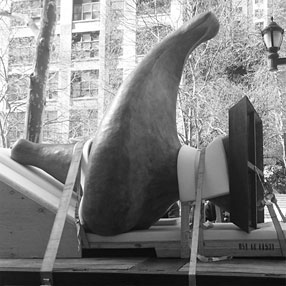Have you ever visited a premier art show, like Art Basel? Pavilions, booths, and exhibition halls are filled with a variety of fine art objects. Antique pieces and modern art installations, large sculptures and fragile items of different forms – all of them cause visitors’ admiration. However, looking at these masterpieces, have you ever thought about how modern artists transport their creations, especially large-scale works? We are ready to reveal some art shipping secrets to you!
Professional art transportation services. Hundreds of art shipping companies around the world, like Fine Art Shippers, specialize in the local and international transportation of art pieces. We provide artists, gallery owners, and auction houses with restful sleep, so they don’t have to worry anymore about the fact that any of their precious art objects will be damaged. To be honest, it is a very hard work. We know a lot of cases and stories about the lost items, broken sculptures, damaged paintings, and deformed installations. That’s why works of art should be transported only in special containers equipped with tilt sensors and anti-shock system, paintings should be placed in carefully built trapezoidal constructions, not to mention the climate control. In this way, to use professional art transportation services is the best way to ship art objects to their destination.
Necessary expenses. Moving oversized items can be easily turned into a large-scale logistics operation. For example, multi-ton sculptures require a lot of effort from art handlers, crane operators, and entire teams of construction experts just to install the work in a museum or an exhibition hall. So it’s not surprising that such professional services require additional expenses borne by museums, galleries, or artists themselves. The same applies to the long-distance transportation. While sea transportation is a relatively inexpensive way of shipping art, it may take several weeks. Air transportation, on the contrary, is much faster but undoutedly more expensive. Anyway, these expenses are necessary to ensure the safe and timely transportation and installation of the exhibited artwork.
Self-service. In the world of gloomy economic conditions, many artists, gallery owners, and art dealers are looking for the way to save money. Therefore, self-service is becoming popular. Some artists send works of art via package services or by international couriers and even transport them in the trunk of their own cars. Well, they do save money but, in most cases, they also receive their works damaged in transit. Certainly, there are some proven ways to minimize fine art shipping costs, but is it worth the risk?
“Smuggling.” Some artists even manage to transport small items, hiding the fact that they are art objects. They hide collages in hand luggage, put statuettes in the suitcase between underwear, as well as dismantle the exhibits, pack the pieces into the luggage, and declare them as “art material.” Let's be honest, such a solution cannot be called reasonable, and it is definitely unsafe.
So many artists, so many unusual ways of transportation! However, planning to transport your own piece of art, make a wise decision and use professional art shipping services. Moreover, the prices offered by Fine Art Shippers are truly very attractive.
